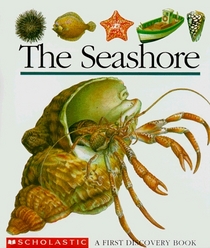Beautiful illustrations! Many of the pictures in this book are printed on clear plastic pages so that you can see different layers of the sea creatures depicted.
this is a beautiful gift book. The << Seashore>> is an essential member of the First Discovery series and deserves to be put back in print. There is no doubt many people (and libraries) would like to have a complete set of these titles.
These First Discovery books never cease to amaze. They pioneer the innovative technique of the "double sided overlay", a brilliant illustrating tool which brings excitement and almost dynamic movement to story telling.
The concept of the Seashore book is to emphasise the interface between land and sea, and that place where man and nature interact. The environmental message is strong eg. " Always replace the stone in the same place when you look in rock pools".
The overlays allow us to see the top and bottom of a crab in great detail. We also see inside the hermit crab's shell and the time he does his house-moving!
If you love to eat shell-fish, you will adore the pictures of the oysters, mussels and scallops. By turning the page you see inside the shell. They look good enough to eat. By the way, why do so many chefs discard those gorgeous roes on scallops?
The scene of the wading birds (curlews and oystercatchers) is done particularly well, We get an "underground view" of the burrowing molluscs and the long curving beaks of the birds at the surface hunting for their supper.
The illustrator's art is at its most brilliant when we are looking at a curtain of brilliantly colored seagrasses. There is something lurking behind here. Turn the page and you are face to face with a moray eel.
Track this book down or lobby the publishers to re-print it. It deserves to get a wider audience.
These First Discovery books never cease to amaze. They pioneer the innovative technique of the "double sided overlay", a brilliant illustrating tool which brings excitement and almost dynamic movement to story telling.
The concept of the Seashore book is to emphasise the interface between land and sea, and that place where man and nature interact. The environmental message is strong eg. " Always replace the stone in the same place when you look in rock pools".
The overlays allow us to see the top and bottom of a crab in great detail. We also see inside the hermit crab's shell and the time he does his house-moving!
If you love to eat shell-fish, you will adore the pictures of the oysters, mussels and scallops. By turning the page you see inside the shell. They look good enough to eat. By the way, why do so many chefs discard those gorgeous roes on scallops?
The scene of the wading birds (curlews and oystercatchers) is done particularly well, We get an "underground view" of the burrowing molluscs and the long curving beaks of the birds at the surface hunting for their supper.
The illustrator's art is at its most brilliant when we are looking at a curtain of brilliantly colored seagrasses. There is something lurking behind here. Turn the page and you are face to face with a moray eel.
Track this book down or lobby the publishers to re-print it. It deserves to get a wider audience.




